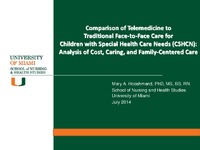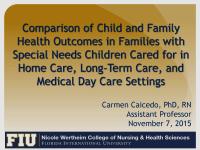| dc.contributor.author | Hooshmand, Mary A. | en |
| dc.date.accessioned | 2014-11-17T13:42:56Z | |
| dc.date.available | 2014-11-17T13:42:56Z | |
| dc.date.issued | 2014-11-17 | |
| dc.identifier | INRC14E05 | |
| dc.identifier.uri | http://hdl.handle.net/10755/335050 | |
| dc.description | <p>International Nursing Research Congress, 2014 Theme: Engaging Colleagues: Improving Global Health Outcomes. Held at the Hong Kong Convention and Exhibition Centre, Wanchai, Hong Kong</p> | en |
| dc.description.abstract | <p>Session presented on Saturday, July 26, 2014:</p>
<p><strong>Purpose:</strong> The purpose of this research project was to examine cost, caring and family-centered care in relation to pediatric specialty services utilizing telemedicine technology compared to traditional face-to-face visits for CSHCN in rural, remote and medically underserved areas of Southeast Florida. Family costs, caring, and family-centered care were examined from the perspectives of the parents/ guardians of CSHCN.</p>
<p><strong>Methods:</strong> A quasi-experimental research design was used with a convenience sample of 222 parents/guardians of CSHCN residing in rural, remote and medically underserved areas of Southeast Florida enrolled in the Children's Medical Services (CMS) program. The sample was comprised of two study groups: traditional (n = 110) which included families receiving traditional face-to-face pediatric specialty care; and the telemedicine group (n = 112) which included families who have received telemedicine visits along with traditional face-to-face pediatric specialty care. Measures of cost, caring, and family-centered care were obtained using three instruments including a Family Cost Survey, Caring Professional Scale (CPS), and Measure of Processes of Care- 20 Item Scale (MPOC-20).</p>
<p><strong>Results:</strong> Results indicated that there were no significant differences in family costs when telemedicine was available locally compared to traditional face-to-face care in the local community. Family costs were reported to be significantly higher if telemedicine was not available in their communities. Families within the telemedicine group reported significantly greater anticipated costs for pediatric specialty care visits if telemedicine had not been available locally. If telemedicine had not been available, parents anticipated significant increases in both costs and burdens to the family including increased mileage/travel, number of family members missing work, loss of wages impacting family weekly incomes, child care needs, lodging, and additional other costs associated with the specialty visit. While there were no differences in the families' perceptions of care as caring, parents in the telemedicine group reported more positive perceptions of the system of care as being family-centered compared to families receiving traditional face-to-face pediatric specialty care. The study results are significant because they indicate that families do perceive systems of care inclusive of telemedicine as family-centered. In fact, while parent/ guardians in both groups reported that they perceived the system of care as family-centered, the scores were significantly higher among the parent/ guardians in the telemedicine group compared to traditional face-to-face care across all domains of family-centered care. These results with significantly higher scores for family-centered care under the telemedicine condition render further investigation. The provider groups were consistent across traditional and telemedicine clinics within the same overall system of care for CSHCN in the Southeast region of Florida. One primary difference observed is that, within the telemedicine clinics, there is consistently a Registered Nurse (or Advanced Registered Nurse Practitioner) with the family during the telemedicine sessions. While traditional clinics may have a Registered Nurse present, they are not consistently with the family throughout the clinical sessions. In contrast, there may be a Licensed Practical Nurse or Medical Assistant with the family and pediatric specialty provider in traditional face-to-face clinics. This warrants further study not only in respect to telemedicine but the possible impact of the Registered Nurse role in terms of effect on family-centered care across the system of care including the pediatric specialty clinics for CSHCN.</p>
<p><strong>Conclusion: </strong>This study demonstrates the acceptance of telemedicine by parents of CSHCN. The use of innovative systems of care such as telemedicine has promise to promote caring, family-centered systems of care in communities. These results together underscore the importance of assuring and facilitating access to pediatric specialty care for CSHCN and their families by further reducing their burdens and costs. Systems of care for CSHCN should be accessible, reduce financial burden, and construed by the recipients of care as caring and family-centered in order to build family- provider partnerships, and optimize health outcomes for CSHCN and their families. The findings of this study indicate that the use of technology, specifically telemedicine, did not diminish the human connection, caring, and this has implications for all kinds of health care technologies. For example, potential technologies could range from video teleconferencing 'home visits' through computer technology connecting families to a community health nurse, medical home, pediatric specialist, or even back to the Neonatal or Pediatric Intensive Care Unit for a follow-up; telemedicine based in pediatrician offices connecting to schools and day cares perhaps conducting 'sick' visits; to the use of twitter or other social networking tools to provide health information or health reminders to a child with Juvenile Diabetes. The possibilities for the use of technology in health care are vast and have not been tapped to their full potential. The results suggest that telemedicine can reduce family cost burden, maintain caring behaviors on the part of health care professionals, and promote caring, family-centered systems of care in local communities. We make the assumption that technology lessens the interpersonal relationship in the health care setting. This study debunks that mindset and provides evidence that the human connection is not lost through the use of technology. In this era of health care reform, this study provides powerful evidence to support expansion of technology in the health care arena.</p> | en |
| dc.format | Text-based Document | en |
| dc.language.iso | en | en |
| dc.subject | Children with Special Health Care Needs | en |
| dc.subject | Cost, Caring and Family-Centered Care | en |
| dc.subject | Telemedicine | en |
| dc.title | Comparison of telemedicine to traditional face-to-face care for children with special healthcare needs: Analysis of cost, caring, and family-centered care | en |
| dc.title.alternative | Utilizing Multiple Technologies to Influence Nursing | en |
| dc.type | Presentation | en |
| dc.rights.holder | <p>
All rights reserved by the author(s) and/or publisher(s) listed in this item record unless relinquished in whole or part by a rights notation or a Creative Commons License present in this item record.
</p><p>
All permission requests should be directed accordingly and not to the Sigma Repository.
</p><p>
All submitting authors or publishers have affirmed that when using material in their work where they do not own copyright, they have obtained permission of the copyright holder prior to submission and the rights holder has been acknowledged as necessary.
</p> | |
| dc.description.note | <p>Items submitted to a conference/event were evaluated/peer-reviewed at the time of abstract submission to the event. No other peer-review was provided prior to submission to the Henderson Repository.</p> | |
| dc.type.category | Full-text | en |
| dc.evidence.level | N/A | en |
| dc.research.approach | N/A | en |
| dc.contributor.department | Beta Tau | en |
| dc.author.details | Mary A. Hooshmand, PhD, MS, BS, RN | en |
| dc.conference.name | 25th International Nursing Research Congress | en |
| dc.conference.host | Sigma Theta Tau International | en |
| dc.conference.location | Hong Kong | en |
| dc.date.conferenceyear | 2014 | |
| dc.description.reviewtype | Abstract Review Only: Reviewed by Event Host | en |
| dc.description.acquisition | Proxy-submission | en |





